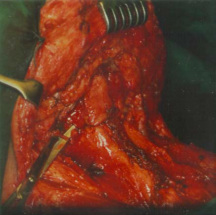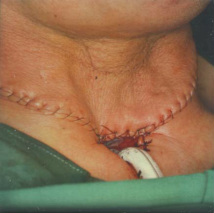Primary tonicity control of the PE-segmentBefore skin closure is completed, the final aspect of the tonicity control of the pharyngoesophageal (PE) segment should be carried out. As already mentioned, a short myotomy of the upper esophageal sphincter is performed before closing the pharyngeal mucosa (video below).
A neurectomy of the pharyngeal plexus often was added to further decrease the chance of hypertonicity. The pharyngeal plexus branches innervating the constrictor pharyngeus muscle were localized, cut and partially removed as careful as possible (figure top right). Mostly, three to five branches can be identified. This procedure was carried out unilaterally, preferably on the side of the hemi-thyroidectomy and/or neck dissection. However, this procedure has largely been abandonned, since it has a too high chance of causing hypotonicity and thus a poor voice. A myotomy of the constrictor pharyngeus muscle is also not recommended routinely. After introduction of wound drains, the skin is closed in two layers: the subcutaneous tissue with 3-0 vicryl interrupted and the skin with 4-0 nylon monofilament running sutures. The end result is shown in the last figure on the right. |

